List of birds of Oklahoma

This list of birds of Oklahoma includes species documented in the U.S. state of Oklahoma and accepted by the Oklahoma Ornithological Society's Bird Records Committee (OBRC). As of May 2022, there were 488 species on the official list.[1] Of them, 114 are classified as accidental, seven have been introduced to North America, two are known to be extinct, and two others might be extinct. An additional 16 species are classed as either hypothetical or of uncertain origin. Two additional accidental species have been added from other sources.
This list is presented in the taxonomic sequence of the Check-list of North and Middle American Birds, 7th edition through the 62nd Supplement, published by the American Ornithological Society (AOS).[2] Common and scientific names are also those of the Check-list, except that the common names of families are from the Clements taxonomy because the AOS list does not include them.
Unless otherwise noted, all species listed below are considered to occur regularly in Oklahoma as permanent residents, summer or winter visitors, or migrants. These tags are used to annotate some species:
- (A) Accidental - Species considered rare or accidental by Bird Checklists of the World (the OBRC does not annotate its list with this category)[3]
- (I) Introduced - a species introduced to North America by the actions of humans, either directly or indirectly
- (E) Extinct - a species that no longer exists
- (H) Hypothetical - "species seen in the state and supported only by written documentation" per the OBRC
- (UO) Uncertain origin - species whose provenance is unknown
Ducks, geese, and waterfowl
[edit]Order: Anseriformes Family: Anatidae
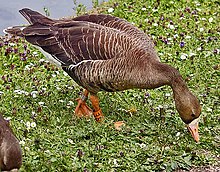



The family Anatidae includes the ducks and most duck-like waterfowl, such as geese and swans. These birds are adapted to an aquatic existence with webbed feet, bills which are flattened to a greater or lesser extent, and feathers that are excellent at shedding water due to special oils.
- Black-bellied whistling-duck, Dendrocygna autumnalis (A)
- Fulvous whistling-duck, Dendrocygna bicolor (A)
- Snow goose, Anser caerulescens
- Ross's goose, Anser rossii (A)
- Greater white-fronted goose, Anser albifrons
- Brant, Branta bernicla
- Barnacle goose, Branta leucopsis (A)
- Cackling goose, Branta hutchinsii
- Canada goose, Branta canadensis
- Mute swan, Cygnus olor (I) (UO)
- Trumpeter swan, Cygnus buccinator
- Tundra swan, Cygnus columbianus (A)
- Wood duck, Aix sponsa
- Baikal teal, Sibirionetta formosa (H)
- Garganey, Spatula querquedula (A)
- Blue-winged teal, Spatula discors
- Cinnamon teal, Spatula cyanoptera (A)
- Northern shoveler, Spatula clypeata
- Gadwall, Mareca strepera
- Eurasian wigeon, Mareca penelope
- American wigeon, Mareca americana
- Mallard, Anas platyrhynchos
- Mexican duck, Anas diazi (A)[4]
- American black duck, Anas rubripes (A)
- Mottled duck, Anas fulvigula
- Northern pintail, Anas acuta
- Green-winged teal, Anas crecca
- Canvasback, Aythya valisineria
- Redhead, Aythya americana
- Ring-necked duck, Aythya collaris
- Greater scaup, Aythya marila (A)
- Lesser scaup, Aythya affinis
- Surf scoter, Melanitta perspicillata (A)
- White-winged scoter, Melanitta deglandi
- Black scoter, Melanitta americana (A)
- Long-tailed duck, Clangula hyemalis (A)
- Bufflehead, Bucephala albeola
- Common goldeneye, Bucephala clangula
- Barrow's goldeneye, Bucephala islandica
- Hooded merganser, Lophodytes cucullatus
- Common merganser, Mergus merganser
- Red-breasted merganser, Mergus serrator
- Masked duck, Nomonyx dominicus (A)
- Ruddy duck, Oxyura jamaicensis
New World quail
[edit]Order: Galliformes Family: Odontophoridae
The New World quails are small, plump terrestrial birds only distantly related to the quails of the Old World, but named for their similar appearance and habits.
- Northern bobwhite, Colinus virginianus
- Scaled quail, Callipepla squamata
Pheasants, grouse, and allies
[edit]Order: Galliformes Family: Phasianidae
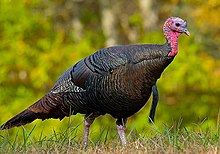
Phasianidae consists of the pheasants and their allies. These are terrestrial species, variable in size but generally plump with broad relatively short wings. Many species are gamebirds or have been domesticated as a food source for humans.
- Wild turkey, Meleagris gallopavo
- Gunnison sage-grouse, Centrocercus minimus (H) (A)
- Sharp-tailed grouse, Tympanuchus phasianellus (H)
- Greater prairie-chicken, Tympanuchus cupido
- Lesser prairie-chicken, Tympanuchus pallidicinctus
- Ring-necked pheasant, Phasianus colchicus (I)
Grebes
[edit]Order: Podicipediformes Family: Podicipedidae

Grebes small to medium-large freshwater diving birds. They have lobed toes and are excellent swimmers and divers. However, they have their feet placed far back on the body, making them quite ungainly on land.
- Least grebe, Tachybaptus dominicus (A)
- Pied-billed grebe, Podilymbus podiceps
- Horned grebe, Podiceps auritus
- Red-necked grebe, Podiceps grisegena (A)
- Eared grebe, Podiceps nigricollis
- Western grebe, Aechmorphorus occidentalis
- Clark's grebe, Aechmorphorus clarkii (A)
Pigeons and doves
[edit]Order: Columbiformes Family: Columbidae

Pigeons and doves are stout-bodied birds with short necks and short slender bills with a fleshy cere.
- Rock pigeon, Columba livia (I)
- Band-tailed pigeon, Patagioenas fasciata
- Eurasian collared-dove, Streptopelia decaocto (I)
- Passenger pigeon, Ectopistes migratorius (E)
- Inca dove, Columbina inca
- Common ground dove, Columbina passerina
- White-winged dove, Zenaida asiatica
- Mourning dove, Zenaida macroura
Cuckoos
[edit]Order: Cuculiformes Family: Cuculidae
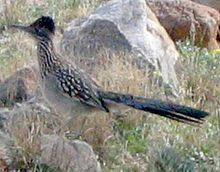
The family Cuculidae includes cuckoos, roadrunners, and anis. These birds are of variable size with slender bodies, long tails, and strong legs. The Old World cuckoos are brood parasites.
- Groove-billed ani, Crotophaga sulcirostris (A)
- Greater roadrunner, Geococcyx californianus
- Yellow-billed cuckoo, Coccyzus americanus
- Black-billed cuckoo, Coccyzus erythropthalmus
Nightjars and allies
[edit]Order: Caprimulgiformes Family: Caprimulgidae
Nightjars are medium-sized nocturnal birds that usually nest on the ground. They have long wings, short legs, and very short bills. Most have small feet, of little use for walking, and long pointed wings. Their soft plumage is cryptically colored to resemble bark or leaves.
- Lesser nighthawk, Chordeiles acutipennis
- Common nighthawk, Chordeiles minor
- Common poorwill, Phalaenoptilus nuttallii (A)
- Chuck-will's-widow, Antrostomus carolinensis
- Eastern whip-poor-will, Antrostomus vociferus
Swifts
[edit]Order: Apodiformes Family: Apodidae

The swifts are small birds which spend the majority of their lives flying. These birds have very short legs and never settle voluntarily on the ground, perching instead only on vertical surfaces. Many swifts have very long swept-back wings which resemble a crescent or boomerang.
- Chimney swift, Chaetura pelagica
- White-throated swift, Aeronautes saxatalis (H) (A)
Hummingbirds
[edit]Order: Apodiformes Family: Trochilidae

Hummingbirds are small birds capable of hovering in mid-air due to the rapid flapping of their wings. They are the only birds that can fly backwards.
- Mexican violetear, Colibri thalassinus (A)
- Rivoli's hummingbird, Eugenes fulgens (A)
- Blue-throated mountain-gem, Lampornis clemenciae (H) (A)
- Ruby-throated hummingbird, Archilochus colubris
- Black-chinned hummingbird, Archilochus alexandri
- Anna's hummingbird, Calypte anna (A)
- Costa's hummingbird, Calypte costae (A)
- Calliope hummingbird, Selasphorus calliope
- Rufous hummingbird, Selasphorus rufus (A)
- Broad-tailed hummingbird, Selasphorus platycercus
- Broad-billed hummingbird, Cynanthus latirostris (A)
Rails, gallinules, and coots
[edit]Order: Gruiformes Family: Rallidae
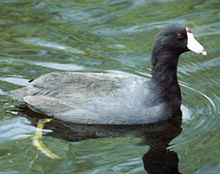
Rallidae is a large family of small to medium-sized birds which includes the rails, crakes, coots, and gallinules. The most typical family members occupy dense vegetation in damp environments near lakes, swamps, or rivers. In general they are shy and secretive birds, making them difficult to observe. Most species have strong legs and long toes which are well adapted to soft uneven surfaces. They tend to have short, rounded wings and to be weak fliers.
- King rail, Rallus elegans
- Virginia rail, Rallus limicola
- Sora, Porzana carolina
- Common gallinule, Gallinula galeata (A)
- American coot, Fulica americana
- Purple gallinule, Porphyrio martinicus (A)
- Yellow rail, Coturnicops noveboracensis
- Black rail, Laterallus jamaicensis
Limpkin
[edit]Order: Gruiformes Family: Aramidae
The limpkin is an odd bird that looks like a large rail, but is skeletally closer to the cranes.
- Limpkin, Aramus guarauna (A)
Cranes
[edit]Order: Gruiformes Family: Gruidae
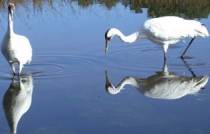
Cranes are large, long-legged, and long-necked birds. Unlike the similar-looking but unrelated herons, cranes fly with necks outstretched, not pulled back. Most have elaborate and noisy courting displays or "dances".
- Sandhill crane, Antigone canadensis (A) (According to eBird records, this species is widespread and common during migration.)
- Common crane, Grus grus (A)
- Whooping crane, Grus americana
Stilts and avocets
[edit]Order: Charadriiformes Family: Recurvirostridae

Recurvirostridae is a family of large wading birds which includes the avocets and stilts. The avocets have long legs and long up-curved bills. The stilts have extremely long legs and long, thin, straight bills.
- Black-necked stilt, Himantopus mexicanus
- American avocet, Recurvirostra americana
Plovers and lapwings
[edit]Order: Charadriiformes Family: Charadriidae
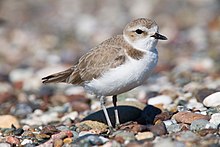
The family Charadriidae includes the plovers, dotterels, and lapwings. They are small to medium-sized birds with compact bodies, short thick necks, and long, usually pointed, wings. They are found in open country worldwide, mostly in habitats near water.
- Black-bellied plover, Pluvialis squatarola
- American golden-plover, Pluvialis dominica
- Killdeer, Charadrius vociferus
- Semipalmated plover, Charadrius semipalmatus
- Piping plover, Charadrius melodus
- Wilson's plover, Charadrius wilsonia (A)
- Snowy plover, Charadrius nivosus (A) (According to eBird records this species is a regularly occurring summer resident.)
- Mountain plover, Charadrius montanus
Sandpipers and allies
[edit]Order: Charadriiformes Family: Scolopacidae



Scolopacidae is a large diverse family of small to medium-sized shorebirds including the sandpipers, curlews, godwits, shanks, tattlers, woodcocks, snipes, dowitchers, and phalaropes. The majority of these species eat small invertebrates picked out of the mud or soil. Different lengths of legs and bills enable multiple species to feed in the same habitat, particularly on the coast, without direct competition for food.
- Upland sandpiper, Bartramia longicauda
- Whimbrel, Numenius phaeopus (A)
- Eskimo curlew, Numenius borealis (Possibly E) (A)
- Long-billed curlew, Numenius americanus
- Hudsonian godwit, Limosa haemastica
- Marbled godwit, Limosa fedoa
- Ruddy turnstone, Arenaria interpres
- Red knot, Calidris canutus
- Ruff, Calidris pugnax (A)
- Stilt sandpiper, Calidris himantopus
- Curlew sandpiper, Calidris ferruginea (H) (A)
- Sanderling, Calidris alba
- Dunlin, Calidris alpina
- Purple sandpiper, Calidris maritima (A)
- Baird's sandpiper, Calidris bairdii
- Least sandpiper, Calidris minutilla
- White-rumped sandpiper, Calidris fuscicollis
- Buff-breasted sandpiper, Calidris subruficollis
- Pectoral sandpiper, Calidris melanotos
- Semipalmated sandpiper, Calidris pusilla
- Western sandpiper, Calidris mauri
- Short-billed dowitcher, Limnodromus griseus
- Long-billed dowitcher, Limnodromus scolopaceus
- American woodcock, Scolopax minor
- Wilson's snipe, Gallinago delicata
- Solitary sandpiper, Tringa solitaria
- Lesser yellowlegs, Tringa flavipes
- Willet, Tringa semipalmata
- Spotted redshank, Tringa erythropus
- Greater yellowlegs, Tringa melanoleuca
- Wilson's phalarope, Phalaropus tricolor
- Red-necked phalarope, Phalaropus lobatus
- Red phalarope, Phalaropus fulicarius
Skuas and jaegers
[edit]Order: Charadriiformes Family: Stercorariidae
Skuas and jaegers are in general medium to large birds, typically with gray or brown plumage, often with white markings on the wings. They have longish bills with hooked tips and webbed feet with sharp claws. They look like large dark gulls, but have a fleshy cere above the upper mandible. They are strong, acrobatic fliers.
- South polar skua, Stercorarius maccormicki (A)
- Pomarine jaeger, Stercorarius pomarinus
- Parasitic jaeger, Stercorarius parasiticus
- Long-tailed jaeger, Stercorarius longicaudus
Gulls, terns, and skimmers
[edit]Order: Charadriiformes Family: Laridae



Laridae is a family of medium to large seabirds and includes gulls, terns, kittiwakes, and skimmers. They are typically gray or white, often with black markings on the head or wings. They have stout, longish bills and webbed feet.
- Black-legged kittiwake, Rissa tridactyla (A)
- Sabine's gull, Xema sabini (A)
- Bonaparte's gull, Chroicocephalus philadelphia
- Black-headed gull, Chroicocephalus ridibundus
- Little gull, Hydrocoloeus minutus (A)
- Laughing gull, Leucophaeus atricilla (A)
- Franklin's gull, Leucophaeus pipixcan
- Heermann's gull, Larus heermanni (A)
- Short-billed gull, Larus brachyrhynchus (A)
- Ring-billed gull, Larus delawarensis
- California gull, Larus californicus
- Herring gull, Larus argentatus
- Iceland gull, Larus glaucoides (A)
- Lesser black-backed gull, Larus fuscus (A)
- Glaucous-winged gull, Larus glaucescens
- Glaucous gull, Larus hyperboreus (A)
- Great black-backed gull, Larus marinus (A)
- Sooty tern, Onychoprion fuscatus (A)
- Least tern, Sternula antillarum
- Caspian tern, Hydroprogne caspia
- Black tern, Chlidonias niger
- Common tern, Sterna hirundo
- Arctic tern, Sterna paradisaea (A)
- Forster's tern, Sterna forsteri
- Royal tern, Thalasseus maximus (A)
- Black skimmer, Rynchops niger
Loons
[edit]Order: Gaviiformes Family: Gaviidae

Loons are aquatic birds, the size of a large duck, to which they are unrelated. Their plumage is largely gray or black, and they have spear-shaped bills. Loons swim well and fly adequately, but are almost hopeless on land, because their legs are placed towards the rear of the body.
- Red-throated loon, Gavia stellata (A)
- Pacific loon, Gavia pacifica (A)
- Common loon, Gavia immer
- Yellow-billed loon, Gavia adamsii
Storks
[edit]Order: Ciconiiformes Family: Ciconiidae

Storks are large, heavy, long-legged, long-necked wading birds with long stout bills and wide wingspans. They lack the powder down that other wading birds such as herons, spoonbills and ibises use to clean off fish slime. Storks lack a pharynx and are mute.
- Jabiru, Jabiru mycteria (A)
- Wood stork, Mycteria americana
Frigatebirds
[edit]Order: Suliformes Family: Fregatidae
Frigatebirds are large seabirds usually found over tropical oceans. They are large, black, or black-and-white, with long wings and deeply forked tails. The males have colored inflatable throat pouches. They do not swim or walk and cannot take off from a flat surface. Having the largest wingspan-to-body-weight ratio of any bird, they are essentially aerial, able to stay aloft for more than a week.
- Magnificent frigatebird, Fregata magnificens
- Great frigatebird, Fregata minor (A)
Boobies and gannets
[edit]Order: Suliformes Family: Sulidae
The sulids comprise the gannets and boobies. Both groups are medium-large coastal seabirds that plunge-dive for fish.
- Brown booby, Sula leucogaster (A)
- Northern gannet, Morus bassanus (H) (A)
Anhingas
[edit]Order: Suliformes Family: Anhingidae
Darters are cormorant-like water birds with very long necks and long, straight beaks. They are fish eaters which often swim with only their neck above the water.
- Anhinga, Anhinga anhinga (A)
Cormorants and shags
[edit]Order: Suliformes Family: Phalacrocoracidae

Cormorants are medium-to-large aquatic birds, usually with mainly dark plumage and areas of colored skin on the face. The bill is long, thin, and sharply hooked. Their feet are four-toed and webbed.
- Double-crested cormorant, Nannopterum auritum
- Neotropic cormorant, Nannopterum brasilianum
Pelicans
[edit]Order: Pelecaniformes Family: Pelecanidae

Pelicans are very large water birds with a distinctive pouch under their beak Like other birds in the order Pelecaniformes, they have four webbed toes.
- American white pelican, Pelecanus erythrorhynchos
- Brown pelican, Pelecanus occidentalis (A)
Herons, egrets, and bitterns
[edit]Order: Pelecaniformes Family: Ardeidae

The family Ardeidae contains the herons, egrets, and bitterns. Herons and egrets are medium to large wading birds with long necks and legs. Bitterns tend to be shorter necked and more secretive. Members of Ardeidae fly with their necks retracted, unlike other long-necked birds such as storks, ibises, and spoonbills.
- American bittern, Botaurus lentiginosus
- Least bittern, Ixobrychus exilis
- Great blue heron, Ardea herodias
- Great egret, Ardea alba
- Snowy egret, Egretta thula
- Little blue heron, Egretta caerulea
- Tricolored heron, Egretta tricolor
- Reddish egret, Egretta rufescens (A)
- Cattle egret, Bubulcus ibis
- Green heron, Butorides virescens
- Black-crowned night-heron, Nycticorax nycticorax
- Yellow-crowned night-heron, Nyctanassa violacea
Ibises and spoonbills
[edit]Order: Pelecaniformes Family: Threskiornithidae

The family Threskiornithidae includes the ibises and spoonbills. They have long, broad wings. Their bodies tends to be elongated, the neck more so, with rather long legs. The bill is also long, decurved in the case of the ibises, straight and distinctively flattened in the spoonbills.
- White ibis, Eudocimus albus (A)
- Glossy ibis, Plegadis falcinellus
- White-faced ibis, Plegadis chihi (A)
- Roseate spoonbill, Platalea ajaja (A)
New World vultures
[edit]Order: Cathartiformes Family: Cathartidae
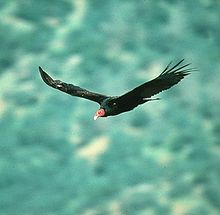
The New World vultures are not closely related to Old World vultures, but superficially resemble them because of convergent evolution. Like the Old World vultures, they are scavengers. However, unlike Old World vultures, which find carcasses by sight, New World vultures have a good sense of smell with which they locate carcasses.
- Black vulture, Coragyps atratus
- Turkey vulture, Cathartes aura
Osprey
[edit]Order: Accipitriformes Family: Pandionidae

Pandionidae is a family of fish-eating birds of prey possessing a very large, powerful hooked beak for tearing flesh from their prey, strong legs, powerful talons, and keen eyesight. The family is monotypic.
- Osprey, Pandion haliaetus
Hawks, eagles, and kites
[edit]Order: Accipitriformes Family: Accipitridae
Accipitridae is a family of birds of prey which includes hawks, eagles, kites, harriers, and Old World vultures. These birds have very large powerful hooked beaks for tearing flesh from their prey, strong legs, powerful talons, and keen eyesight.
- White-tailed kite, Elanus leucurus
- Swallow-tailed kite, Elanoides forficatus
- Golden eagle, Aquila chrysaetos
- Northern harrier, Circus hudsonius
- Sharp-shinned hawk, Accipiter striatus
- Cooper's hawk, Accipiter cooperii
- American goshawk, Accipiter atricapillus
- Bald eagle, Haliaeetus leucocephalus
- Mississippi kite, Ictinia mississippiensis
- Common black hawk, Buteogallus anthracinus (A)
- Harris's hawk, Parabuteo unicinctus
- Gray hawk, Buteo plagiatus (H) (A)
- Red-shouldered hawk, Buteo lineatus
- Broad-winged hawk, Buteo platypterus
- Swainson's hawk, Buteo swainsoni
- Zone-tailed hawk, Buteo albonotatus (A)
- Red-tailed hawk, Buteo jamaicensis
- Rough-legged hawk, Buteo lagopus
- Ferruginous hawk, Buteo regalis
Barn-owls
[edit]Order: Strigiformes Family: Tytonidae

Barn owls are medium to large owls with large heads and characteristic heart-shaped faces. They have long strong legs with powerful talons.
- Barn owl, Tyto alba
Owls
[edit]Order: Strigiformes Family: Strigidae
Typical owls are small to large solitary nocturnal birds of prey. They have large forward-facing eyes and ears, a hawk-like beak, and a conspicuous circle of feathers around each eye called a facial disk.
- Western screech-owl, Megascops kennicottii
- Eastern screech-owl, Megascops asio
- Great horned owl, Bubo virginianus
- Snowy owl, Bubo scandiacus (A)
- Burrowing owl, Athene cunicularia (A)
- Barred owl, Strix varia
- Long-eared owl, Asio otus
- Short-eared owl, Asio flammeus
- Northern saw-whet owl, Aegolius acadicus (A)
Kingfishers
[edit]Order: Coraciiformes Family: Alcedinidae
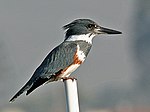
Kingfishers are medium-sized birds with large heads, long pointed bills, short legs, and stubby tails.
- Ringed kingfisher, Megaceryle torquata (A)
- Belted kingfisher, Megaceryle alcyon
Woodpeckers
[edit]Order: Piciformes Family: Picidae

Woodpeckers are small to medium-sized birds with chisel-like beaks, short legs, stiff tails, and long tongues used for capturing insects. Some species have feet with two toes pointing forward and two backward, while several species have only three toes. Many woodpeckers have the habit of tapping noisily on tree trunks with their beaks.
- Lewis's woodpecker, Melanerpes lewis
- Red-headed woodpecker, Melanerpes erythrocephalus
- Acorn woodpecker, Melanerpes formicivorus
- Golden-fronted woodpecker, Melanerpes aurifrons
- Red-bellied woodpecker, Melanerpes carolinus
- Williamson's sapsucker, Sphyrapicus thyroideus
- Yellow-bellied sapsucker, Sphyrapicus varius
- Red-naped sapsucker, Sphyrapicus nuchalis
- Downy woodpecker, Dryobates pubescens
- Ladder-backed woodpecker, Dryobates scalaris
- Red-cockaded woodpecker, Dryobates borealis
- Hairy woodpecker, Dryobates villosus
- Northern flicker, Colaptes auratus
- Pileated woodpecker, Dryocopus pileatus
- Ivory-billed woodpecker, Campephilus principalis (A) (The OBRC classes this species as "possibly extinct", but see its page for the controversy surrounding it.)
Falcons and caracaras
[edit]Order: Falconiformes Family: Falconidae

Falconidae is a family of diurnal birds of prey, notably the falcons and caracaras. They differ from hawks, eagles, and kites in that they kill with their beaks instead of their talons.
- Crested caracara, Caracara plancus
- American kestrel, Falco sparverius
- Merlin, Falco columbarius
- Gyrfalcon, Falco rusticolus
- Peregrine falcon, Falco peregrinus
- Prairie falcon, Falco mexicanus
New World and African parrots
[edit]Order: Psittaciformes Family: Psittacidae
Parrots are small to large birds with a characteristic curved beak. Their upper mandibles have slight mobility in the joint with the skull and they have a generally erect stance. All parrots are zygodactyl, having the four toes on each foot placed two at the front and two to the back. Most of the more than 150 species in this family are found in the New World.
- Monk parakeet, Myiopsitta monachus (I) (UO) (A)
- Carolina parakeet, Conuropsis carolinensis (E)
Tyrant flycatchers
[edit]Order: Passeriformes Family: Tyrannidae


Tyrant flycatchers are Passerine birds which occur throughout North and South America. They superficially resemble the Old World flycatchers, but are more robust and have stronger bills. They do not have the sophisticated vocal capabilities of the songbirds. Most, but not all, are rather plain. As the name implies, most are insectivorous.
- Dusky-capped flycatcher, Myiarchus tuberculifer (H) (A)
- Ash-throated flycatcher, Myiarchus cinerascens
- Great crested flycatcher, Myiarchus crinitus
- Great kiskadee, Pitangus sulphuratus (A)
- Couch's kingbird, Tyrannus couchii (A)
- Cassin's kingbird, Tyrannus vociferans
- Western kingbird, Tyrannus verticalis
- Eastern kingbird, Tyrannus tyrannus
- Scissor-tailed flycatcher, Tyrannus forficatus
- Olive-sided flycatcher, Contopus cooperi
- Western wood-pewee, Contopus sordidulus
- Eastern wood-pewee, Contopus virens
- Yellow-bellied flycatcher, Empidonax flaviventris
- Acadian flycatcher, Empidonax virescens
- Alder flycatcher, Empidonax alnorum (A)
- Willow flycatcher, Empidonax traillii
- Least flycatcher, Empidonax minimus
- Hammond's flycatcher, Empidonax hammondii
- Gray flycatcher, Empidonax wrightii (A)
- Dusky flycatcher, Empidonax oberholseri
- Western flycatcher, Empidonax difficilis
- Black phoebe, Sayornis nigricans (A)
- Eastern phoebe, Sayornis phoebe
- Say's phoebe, Sayornis saya (A)
- Vermilion flycatcher, Pyrocephalus rubinus (A)
Vireos, shrike-babblers, and erpornis
[edit]Order: Passeriformes Family: Vireonidae

The vireos are a group of small to medium-sized passerine birds. They are typically greenish in color and resemble wood-warblers apart from their heavier bills.
- Black-capped vireo, Vireo atricapilla (A)
- White-eyed vireo, Vireo griseus
- Bell's vireo, Vireo bellii
- Gray vireo, Vireo vicinior
- Yellow-throated vireo, Vireo flavifrons
- Cassin's vireo, Vireo cassinii
- Blue-headed vireo, Vireo solitarius
- Plumbeous vireo, Vireo plumbeus
- Philadelphia vireo, Vireo philadelphicus
- Warbling vireo, Vireo gilvus
- Red-eyed vireo, Vireo olivaceus
Shrikes
[edit]Order: Passeriformes Family: Laniidae
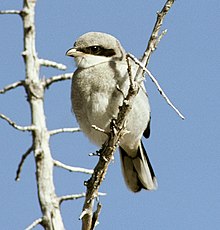
Shrikes are passerine birds known for their habit of catching other birds and small animals and impaling the uneaten portions of their bodies on thorns. A shrike's beak is hooked, like that of a typical bird of prey.
- Loggerhead shrike, Lanius ludovicianus
- Northern shrike, Lanius borealis
Crows, jays, and magpies
[edit]Order: Passeriformes Family: Corvidae


The family Corvidae includes crows, ravens, jays, choughs, magpies, treepies, nutcrackers, and ground jays. Corvids are above average in size among the Passeriformes, and some of the larger species show high levels of intelligence.
- Canada jay, Perisoreus canadensis (H) (A)
- Pinyon jay, Gymnorhinus cyanocephalus
- Steller's jay, Cyanocitta stelleri
- Blue jay, Cyanocitta cristata
- Woodhouse's scrub-jay, Aphelocoma woodhouseii
- Clark's nutcracker, Nucifraga columbiana (A)
- Black-billed magpie, Pica hudsonia
- American crow, Corvus brachyrhynchos
- Fish crow, Corvus ossifragus
- Chihuahuan raven, Corvus cryptoleucus
- Common raven, Corvus corax
Tits, chickadees, and titmice
[edit]Order: Passeriformes Family: Paridae

The Paridae are mainly small stocky woodland species with short stout bills. Some have crests. They are adaptable birds, with a mixed diet including seeds and insects.
- Carolina chickadee, Poecile carolinensis
- Black-capped chickadee, Poecile atricapilla
- Mountain chickadee, Poecile gambeli
- Juniper titmouse, Baeolophus ridgwayi
- Tufted titmouse, Baeolophus bicolor
- Black-crested titmouse, Baeolophus atricristatus
Penduline-tits
[edit]Order: Passeriformes Family: Remizidae
The penduline-tits are a group of small passerine birds related to the true tits. They are insectivores.
- Verdin, Auriparus flaviceps
Larks
[edit]Order: Passeriformes Family: Alaudidae
Larks are small terrestrial birds with often extravagant songs and display flights. Most larks are fairly dull in appearance. Their food is insects and seeds.
- Horned lark, Eremophila alpestris
Swallows
[edit]Order: Passeriformes Family: Hirundinidae

The family Hirundinidae is adapted to aerial feeding. They have a slender streamlined body, long pointed wings, and a short bill with a wide gape. The feet are adapted to perching rather than walking, and the front toes are partially joined at the base.
- Bank swallow, Riparia riparia
- Tree swallow, Tachycineta bicolor
- Violet-green swallow, Tachycineta thalassina (A)
- Northern rough-winged swallow, Stelgidopteryx serripennis
- Purple martin, Progne subis
- Barn swallow, Hirundo rustica
- Cliff swallow, Petrochelidon pyrrhonota
- Cave swallow, Petrochelidon fulva (A)
Long-tailed tits
[edit]Order: Passeriformes Family: Aegithalidae
Long-tailed tits are a group of small passerine birds with medium to long tails. They make woven bag nests in trees. Most eat a mixed diet which includes insects.
- Bushtit, Psaltriparus minimus
Kinglets
[edit]Order: Passeriformes Family: Regulidae
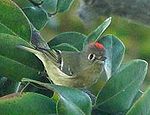
The kinglets are a small family of birds which resemble the titmice. They are very small insectivorous birds. The adults have colored crowns, giving rise to their name.
- Ruby-crowned kinglet, Corthylio calendula
- Golden-crowned kinglet, Regulus satrapa
Waxwings
[edit]Order: Passeriformes Family: Bombycillidae
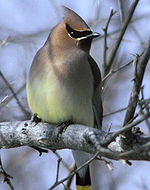
The waxwings are a group of birds with soft silky plumage and unique red tips to some of the wing feathers. In the Bohemian and cedar waxwings, these tips look like sealing wax and give the group its name. These are arboreal birds of northern forests. They live on insects in summer and berries in winter.
- Bohemian waxwing, Bombycilla garrulus (A)
- Cedar waxwing, Bombycilla cedrorum
Silky-flycatchers
[edit]Order: Passeriformes Family: Ptiliogonatidae
The silky-flycatchers are a small family of passerine birds which occur mainly in Central America, although the range of one species extends to central California. They are related to waxwings and like that group, have soft silky plumage, usually gray or pale-yellow. They have small crests.
- Phainopepla, Phainopepla nitens (H) (A)
Nuthatches
[edit]Order: Passeriformes Family: Sittidae
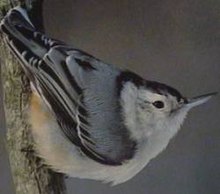
Nuthatches are small woodland birds. They have the unusual ability to climb down trees head first, unlike other birds which can only go upwards. Nuthatches have big heads, short tails, and powerful bills and feet.
- Red-breasted nuthatch, Sitta canadensis
- White-breasted nuthatch, Sitta carolinensis
- Pygmy nuthatch, Sitta pygmaea
- Brown-headed nuthatch, Sitta pusilla
Treecreepers
[edit]Order: Passeriformes Family: Certhiidae
Treecreepers are small woodland birds, brown above and white below. They have thin pointed down-curved bills, which they use to extricate insects from bark. They have stiff tail feathers, like woodpeckers, which they use to support themselves on vertical trees.
- Brown creeper, Certhia americana
Gnatcatchers
[edit]Order: Passeriformes Family: Polioptilidae
These dainty birds resemble Old World warblers in their structure and habits, moving restlessly through the foliage seeking insects. The gnatcatchers are mainly soft bluish gray in color and have the typical insectivore's long sharp bill. Many species have distinctive black head patterns (especially males) and long, regularly cocked, black-and-white tails.
- Blue-gray gnatcatcher, Polioptila caerulea
Wrens
[edit]Order: Passeriformes Family: Troglodytidae

Wrens are small and inconspicuous birds, except for their loud songs. They have short wings and thin down-turned bills. Several species often hold their tails upright. All are insectivorous.
- Rock wren, Salpinctes obsoletus (A)
- Canyon wren, Catherpes mexicanus
- House wren, Troglodytes aedon
- Winter wren, Troglodytes hiemalis
- Sedge wren, Cistothorus platensis
- Marsh wren, Cistothorus palustris
- Carolina wren, Thryothorus ludovicianus
- Bewick's wren, Thryomanes bewickii
Mockingbirds and thrashers
[edit]Order: Passeriformes Family: Mimidae

The mimids are a family of passerine birds which includes thrashers, mockingbirds, tremblers, and the New World catbirds. These birds are notable for their vocalization, especially their remarkable ability to mimic a wide variety of birds and other sounds heard outdoors. The species tend towards dull grays and browns in their appearance.
- Gray catbird, Dumetella carolinensis
- Curve-billed thrasher, Toxostoma curvirostre
- Brown thrasher, Toxostoma rufum
- Sage thrasher, Oreoscoptes montanus
- Northern mockingbird, Mimus polyglottos
Starlings
[edit]Order: Passeriformes Family: Sturnidae
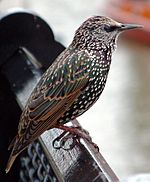
Starlings are small to medium-sized passerine birds. They are medium-sized passerines with strong feet. Their flight is strong and direct and they are very gregarious. Their preferred habitat is fairly open country, and they eat insects and fruit. Plumage is typically dark with a metallic sheen.
- European starling, Sturnus vulgaris (I)
Thrushes and allies
[edit]Order: Passeriformes Family: Turdidae

The thrushes are a group of passerine birds that occur mainly but not exclusively in the Old World. They are plump, soft plumaged, small to medium-sized insectivores or sometimes omnivores, often feeding on the ground. Many have attractive songs.
- Eastern bluebird, Sialia sialis
- Western bluebird, Sialia mexicana
- Mountain bluebird, Sialia currucoides (A)
- Townsend's solitaire, Myadestes townsendi (A)
- Veery, Catharus fuscescens
- Gray-cheeked thrush, Catharus minimus
- Swainson's thrush, Catharus ustulatus
- Hermit thrush, Catharus guttatus
- Wood thrush, Hylocichla mustelina
- American robin, Turdus migratorius
- Varied thrush, Ixoreus naevius (A)
Old World sparrows
[edit]Order: Passeriformes Family: Passeridae

Old World sparrows are small passerine birds. In general, sparrows tend to be small plump brownish or grayish birds with short tails and short powerful beaks. Sparrows are seed eaters, but they also consume small insects.
- House sparrow, Passer domesticus (I)
Wagtails and pipits
[edit]Order: Passeriformes Family: Motacillidae

Motacillidae is a family of small passerine birds with medium to long tails. They include the wagtails, longclaws, and pipits. They are slender ground-feeding insectivores of open country.
- American pipit, Anthus rubescens
- Sprague's pipit, Anthus spragueii
Finches, euphonias, and allies
[edit]Order: Passeriformes Family: Fringillidae
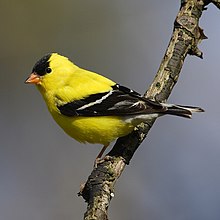
Finches are seed-eating passerine birds, that are small to moderately large and have a strong beak, usually conical and in some species very large. All have twelve tail feathers and nine primaries. These birds have a bouncing flight with alternating bouts of flapping and gliding on closed wings, and most sing well.
- Evening grosbeak, Coccothraustes vespertinus
- Pine grosbeak, Pinicola enucleator (A)
- House finch, Haemorhous mexicanus
- Purple finch, Haemorhous purpureus
- Cassin's finch, Haemorhous cassinii
- Common redpoll, Acanthis flammea (A)
- Red crossbill, Loxia curvirostra (A)
- White-winged crossbill, Loxia leucoptera (A)
- Pine siskin, Spinus pinus
- Lesser goldfinch, Spinus psaltria
- Lawrence's goldfinch, Spinus lawrencei (A)
- American goldfinch, Spinus tristis
Longspurs and snow buntings
[edit]Order: Passeriformes Family: Calcariidae
The Calcariidae are a group of passerine birds that were traditionally grouped with the New World sparrows, but differ in a number of respects and are usually found in open grassy areas.
- Lapland longspur, Calcarius lapponicus
- Chestnut-collared longspur, Calcarius ornatus
- Smith's longspur, Calcarius pictus
- Thick-billed longspur, Rhynchophanes mccownii
- Snow bunting, Plectrophenax nivalis
New World sparrows
[edit]Order: Passeriformes Family: Passerellidae


Until 2017, these species were considered part of the family Emberizidae. Most of the species are known as sparrows, but these birds are not closely related to the Old World sparrows which are in the family Passeridae. Many of these have distinctive head patterns.
- Cassin's sparrow, Peucaea cassinii
- Bachman's sparrow, Peucaea aestivalis
- Grasshopper sparrow, Ammodramus savannarum
- Rufous-collared sparrow, Zonotrichia capensis (A)[5]
- Black-throated sparrow, Amphispiza bilineata
- Lark sparrow, Chondestes grammacus
- Lark bunting, Calamospiza melanocorys (A)
- Chipping sparrow, Spizella passerina
- Clay-colored sparrow, Spizella pallida
- Field sparrow, Spizella pusilla
- Brewer's sparrow, Spizella breweri
- Fox sparrow, Passerella iliaca
- American tree sparrow, Spizelloides arborea
- Dark-eyed junco, Junco hyemalis
- White-crowned sparrow, Zonotrichia leucophrys
- Golden-crowned sparrow, Zonotrichia atricapilla (A)
- Harris's sparrow, Zonotrichia querula
- White-throated sparrow, Zonotrichia albicollis
- Sagebrush sparrow, Artemisiospiza nevadensis
- Vesper sparrow, Pooecetes gramineus
- LeConte's sparrow, Ammospiza leconteii
- Nelson's sparrow, Ammospiza nelsoni (A)
- Baird's sparrow, Centronyx bairdii
- Henslow's sparrow, Centronyx henslowii (A)
- Savannah sparrow, Passerculus sandwichensis
- Song sparrow, Melospiza melodia
- Lincoln's sparrow, Melospiza lincolnii
- Swamp sparrow, Melospiza georgiana
- Canyon towhee, Melozone fuscus
- Rufous-crowned sparrow, Aimophila ruficeps
- Green-tailed towhee, Pipilo chlorurus
- Spotted towhee, Pipilo maculatus
- Eastern towhee, Pipilo erythrophthalmus
Yellow-breasted chat
[edit]Order: Passeriformes Family: Icteriidae
This species was historically placed in the wood-warblers (Parulidae) but nonetheless most authorities were unsure if it belonged there. It was placed in its own family in 2017.
- Yellow-breasted chat, Icteria virens
Troupials and allies
[edit]Order: Passeriformes Family: Icteridae

The icterids are a group of small to medium-sized, often colorful passerine birds restricted to the New World and include the grackles, New World blackbirds, and New World orioles. Most species have black as a predominant plumage color, often enlivened by yellow, orange, or red.
- Yellow-headed blackbird, Xanthocephalus xanthocephalus
- Bobolink, Dolichonyx oryzivorus
- Eastern meadowlark, Sturnella magna
- Western meadowlark, Sturnella neglecta
- Orchard oriole, Icterus spurius
- Hooded oriole, Icterus cucullatus (A)
- Bullock's oriole, Icterus bullockii
- Baltimore oriole, Icterus galbula
- Scott's oriole, Icterus parisorum (A)
- Red-winged blackbird, Agelaius phoeniceus
- Shiny cowbird, Molothrus bonariensis
- Bronzed cowbird, Molothrus aeneus (A)
- Brown-headed cowbird, Molothrus ater
- Rusty blackbird, Euphagus carolinus
- Brewer's blackbird, Euphagus cyanocephalus
- Common grackle, Quiscalus quiscula
- Great-tailed grackle, Quiscalus mexicanus
New World warblers
[edit]Order: Passeriformes Family: Parulidae



The wood-warblers are a group of small often colorful passerine birds restricted to the New World. Most are arboreal, but some are more terrestrial. Most members of this family are insectivores.
- Ovenbird, Seiurus aurocapilla
- Worm-eating warbler, Helmitheros vermivorum (A)
- Louisiana waterthrush, Parkesia motacilla
- Northern waterthrush, Parkesia noveboracensis
- Golden-winged warbler, Vermivora chrysoptera (A)
- Blue-winged warbler, Vermivora cyanoptera (A)
- Black-and-white warbler, Mniotilta varia
- Prothonotary warbler, Protonotaria citrea
- Swainson's warbler, Limnothlypis swainsonii (A)
- Tennessee warbler, Leiothlypis peregrina
- Orange-crowned warbler, Leiothlypis celata
- Nashville warbler, Leiothlypis ruficapilla
- Virginia's warbler, Leiothlypis virginiae
- Connecticut warbler, Oporornis agilis (A)
- MacGillivray's warbler, Geothlypis tolmiei
- Mourning warbler, Geothlypis philadelphia
- Kentucky warbler, Geothlypis formosa
- Common yellowthroat, Geothlypis trichas
- Hooded warbler, Setophaga citrina (A)
- American redstart, Setophaga ruticilla
- Cape May warbler, Setophaga tigrina (A)
- Cerulean warbler, Setophaga cerulea (A)
- Northern parula, Setophaga americana
- Magnolia warbler, Setophaga magnolia
- Bay-breasted warbler, Setophaga castanea
- Blackburnian warbler, Setophaga fusca
- Yellow warbler, Setophaga petechia
- Chestnut-sided warbler, Setophaga pensylvanica
- Blackpoll warbler, Setophaga striata
- Black-throated blue warbler, Setophaga caerulescens (A)
- Palm warbler, Setophaga palmarum
- Pine warbler, Setophaga pinus (A)
- Yellow-rumped warbler, Setophaga coronata
- Yellow-throated warbler, Setophaga dominica
- Prairie warbler, Setophaga discolor (A)
- Grace's warbler, Setophaga graciae (H) (A)
- Black-throated gray warbler, Setophaga nigrescens
- Townsend's warbler, Setophaga townsendi
- Golden-cheeked warbler, Setophaga chrysoparia (H) (A)
- Black-throated green warbler, Setophaga virens
- Canada warbler, Cardellina canadensis
- Wilson's warbler, Cardellina pusilla
Cardinals and allies
[edit]Order: Passeriformes Family: Cardinalidae

The cardinals are a family of robust, seed-eating birds with strong bills. They are typically associated with open woodland. The sexes usually have distinct plumages.
- Hepatic tanager, Piranga flava (A)
- Summer tanager, Piranga rubra
- Scarlet tanager, Piranga olivacea (A)
- Western tanager, Piranga ludoviciana (A)
- Northern cardinal, Cardinalis cardinalis
- Pyrrhuloxia, Cardinalis sinuatus
- Rose-breasted grosbeak, Pheucticus ludovicianus
- Black-headed grosbeak, Pheucticus melanocephalus (A)
- Blue grosbeak, Passerina caerulea
- Lazuli bunting, Passerina amoena (A)
- Indigo bunting, Passerina cyanea
- Painted bunting, Passerina ciris
- Dickcissel, Spiza americana
See also
[edit]Notes
[edit]References
[edit]- ^ Joseph A. Grzybowski; et al. (October 2017). "Checklist of Oklahoma Birds". Oklahoma Bird Records Committee of the Oklahoma Ornithological Society. Retrieved August 11, 2021.
- ^ "Check-list of North and Middle American Birds". American Ornithological Society. June 29, 2021. Retrieved August 9, 2021.
- ^ Lepage, Denis (December 22, 2019). "Checklist of Birds of Oklahoma". Avibase bird checklists of the world. Retrieved July 5, 2020.
- ^ Lepage, Denis. "Mexican Duck". Avibase. Retrieved 4 January 2024.
- ^ "Rufous-collared Sparrow". iNaturalist. Retrieved 10 February 2024.
